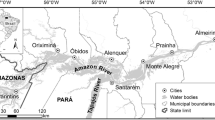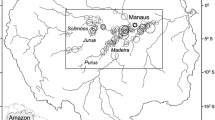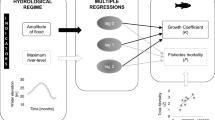Abstract
This paper investigates the relationship between the hydroclimatic parameters (rainfall and flood index) and the catch, stock abundance and recruitment of the catfish, Chrysichthys nigrodigitatus (Bagridae) and the bonga, Ethmalosa fimbriata (Clupeidae) of southeastern Nigeria's inshore waters. For C. nigrodigitatus, most peaks in the mean biomass \((\Delta \% {\bar B})\) and recruitment \((\Delta \% {\bar R(n)})\) curves occurred during the 'wet' years, i.e., years for which the percentage deviations of rainfall \((\Delta \% \overline {{RF}} )\) and flood index \((\Delta \% \overline {{FI}} - 1)\) from their means remained above their averages. Catch and abundance respectively showed good positive linear correlation with the flood index. E. fimbriata behaved differently; some peaks in the \(\Delta \% {\bar B}\) and \(\Delta \% {\bar R(n)}\) curves occurred in the 'wet' and some in the 'dry' years; and there was no correlation between the annual catch of bonga and either the rainfall or the flood index. The hypothesis, that linear relationships exist between the interannual variations in the hydroregime and the yearly fluctuations in the catch and population structure of some coastal and estuarine fishes, holds true for the catfish, C. nigrodigitatus, but not for bonga, E. fimbriata.
Similar content being viewed by others
References
Banerji, S.K. 1974. Frame surveys and associated sample survey designs for theassessment of marine fish landings. FAO, Rome. 15 pp.
Bazigos, G.P. 1974a. Design of fisheries statisticalsurveys, inland waters. FAO Fish. Tech. Pap. 133. 122 pp.
Bazigos, G.P. 1974b. Applied fisherystatistics. FAO Fish Tech. Pap. 135. 164 pp.
Belvéze, H. & K. Erzini 1983. The influenceof hydroclimatic factors on the availability of the sardine (Sardina pilchardus, Walbaum) in the Moroccan Atlantic Fishery. pp. 285–327. In: J.D. Sharp & J. Csirke (ed.) Proceedings of the Expert Consultation to Examine Changes in Abundance and Species Composition of Neritic Fish Resources, FAO Fish. Rep. 291, Vol. 2, Rome.
Beverton, R.J.H. & S.J. Holt. 1957. On the dynamics of exploited fish populations. Fishery InvestigationsSeries II, Volume XIX, Ministry of Agriculture, Fisheries and Food, London. 533 pp.
Bhattacharya, C.G.1967. A simple method of resolution of a distribution into Gaussian components. Biometrics 23: 115–135.
Cadima, E.L. 1978. Cohort analysis. pp. 49–60. In: Models for Fish Stock Assessment, FAO FishCirc. 701, Rome.
Committee for the Eastern Central Atlantic Fishery (CECAF) 1979. Report of the ad hocWorking Group on West African coastal pelagics from Mauritania to Liberia (26°N to 5°N). FAO, Rome. 161 pp.
Food and Agriculture Organization of the United Nations (FAO) 1969. Fisheries SurveyinWestern and Midwestern Regions of Nigeria. FAO, Rome. 142 pp.
FAO 1980. The collection of catch andeffort statistics. FAO Fish. Circ. 730, Rome. 63 pp.
Halyk, L.C & E.K. Balon 1983. Structure andecological production of fish taxocene of a small floodplain system. Can. J. Zool. 61: 2446–2564.
Ilesanmi, O.O. 1972. Onset, advance and retreat of rainfall in Nigeria, an empirical formulation. Niger. agric.J. 9: 128–139.
Lassen, H. 1988. Splitting length distribution into peaks and the clean class concept.Fishbyte 6: 11–14.
Lowe-McConnell, H.R. 1975. Fish communities in tropical freshwater.Longman, London. 337 pp.
Low-McConnell, R.H. 1987. Ecological studies in tropical fish communities.Cambridge University Press, Cambridge. 382 pp.
Milliman, J.D. 1990. Fluvial sediment in coastal seas, fluxand fate. Nature & Resources 26: 12–22.
Moses, B.S. 1979. The Cross River, its ecology andfisheries. pp. 366–371. In: Proceedings of the International Conference on Kainji Lake and River Basins Development in Africa, Kainji Lake Research Institute (K.L.R.I.), New Bussa.
Moses, B.S. 1987. Theinfluence of flood regime on fish catch and fish communities of the Cross River floodplain ecosystem, Nigeria. Env. Biol. Fish. 18: 51–65.
Moses, B.S. 1988. Growth, mortality and potential yield of bonga, Ethmalosa fimbriata(Bowdich, 1825) of Nigerian inshore waters. Fish. Res. 6: 233–247.
Moses, B.S. 1990a.Distribution, ecology and fisheries potentials of Nigerian wetlands. pp. 35–54. In: T.V.I. Akpata & D.U.U. Okali (ed.) NigerianWetlands, Man and the Biosphere (UNESCO) National Committee, Lagos.
Moses, B.S. 1990b. Growth, biomass, mortality production and potential yield of the West African clam, Egeriaradiata (Lamarck) (Lamelliranchia, Donacidae) in the Cross River system, Nigeria. Hydobiologia 196: 1–15.
Moses, B.S. 1990c. The status of artisanal fisheries and fish resources conservation in south-eastern Nigeria.Trans. Nig. Soc. Biol. Conserv. 1: 43–60.
Moses, B.S. 1997. Artisanal fisheries of southeasternNigeria: catch rates, population dynamics, potential yields and resources management. Ph.D Dissertation, University of Uyo, Uyo. 334 pp.
Pauly, D. 1984. Some simple methods for assessment of tropical fish stocks. FAO Fish,Tech. Pap. 234. 52 pp.
Ricker, W.E. 1975. Computation and interpretation of biological statistics of fishpopulation. Department of Fisheries and Oceans, Ottawa. 382 pp.
Sparre, P. & S.C. Venema 1992.Introduction to tropical fish stock assessment. FAO Fish Tech. Pap. 306, Rev. 1, Rome. 376 pp.
Welcomme, R.L. 1975. The fisheries ecology of African floodplains. C.I.F.A Occasional Paper 1,FAO, Rome. 11 pp.
Welcomme, R.L. 1979. Fisheries ecology of floodplain rivers. Longman, London.317 pp.
Welcomme, R.L. 1983. River basin. FAO Fish. Tech. Pap. 202, Rome. 60 pp.
Welcomme, R.L. 1985. River fisheries. FAO Fish Tech. Pap. 262, Rome. 330 pp.
Author information
Authors and Affiliations
Rights and permissions
About this article
Cite this article
Moses, B.S. The Influence of Hydroregime on Catch, Abundance And Recruitment of the Catfish, Chrysichthys Nigrodigitatus (Bagridae) and the Bonga, Ethmalosa Fimbriata (Clupeidae) of Southeastern Nigeria's Inshore Waters. Environmental Biology of Fishes 61, 99–109 (2001). https://doi.org/10.1023/A:1011087604758
Issue Date:
DOI: https://doi.org/10.1023/A:1011087604758




